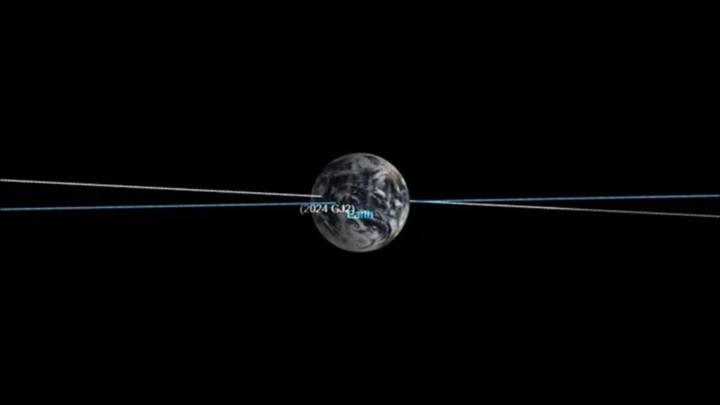A newly discovered asteroid flew past Earth at 1:28:42 a.m. on April 12, Vietnam time. The distance this celestial body created with the blue planet was described as very close, and fortunately harmless.
The asteroid, called 2024 GJ2, is about the size of a car. Since its discovery on April 9, astronomers have calculated that it will pass by Earth at a distance of just 18,700 kilometers (11,100 miles) — just 3 percent of the distance between Earth and the moon. That’s closer than the US’s GOES geostationary environmental satellite, which flies at an altitude of nearly 36,000 kilometers (22,000 miles).

Illustration of the orbits of 2024 GJ2 (white) and Earth (blue). (Image: NASA)
According to the European Space Agency (ESA), 2024 GJ2 is between 2.5 and 5 meters in size. With such a size, even if it were to crash straight into our planet, it would quickly burn up due to friction with the atmosphere.
According to the ESA Near Earth Object Coordination Centre, the asteroid will not make another close approach to Earth until 2093. Even then, it will not be as close as it is now. GJ2’s 2093 approach is estimated to be 205,947 km (125,000 miles) – 10 times farther than its last close approach and more than half the distance between Earth and the Moon.
To date, NASA has cataloged nearly 35,000 near-Earth asteroids, and very few of them pose any threat to our planet.
The space around Earth is not exactly quiet. According to NASA, about 48.5 tons of meteorites fall to Earth every day. Most of these meteorites are very small, perhaps as small as a grain of sand, and burn up as soon as they enter Earth’s atmosphere.
The Planetary Science Institute estimates that for a meteorite to reach the ground, it would have to be at least 25 meters across when it hits the atmosphere.
According to NASA, an asteroid the size of a car hits our planet about once a year.
To be capable of causing global destruction, an asteroid must be 1-2 km in size. A 10 km asteroid is enough to cause a planetary extinction event. In the past, the Chicxulub asteroid that contributed to the "wiping out" of dinosaurs on our planet was this size.
Source




















































![[Maritime News] More than 80% of global container shipping capacity is in the hands of MSC and major shipping alliances](https://vphoto.vietnam.vn/thumb/402x226/vietnam/resource/IMAGE/2025/7/16/6b4d586c984b4cbf8c5680352b9eaeb0)













































Comment (0)